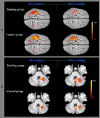Changes in brain activation patterns according to cross-training effect in serial reaction time task: An functional MRI study
- PMID: 25206709
- PMCID: PMC4145986
- DOI: 10.3969/j.issn.1673-5374.2013.07.008
Changes in brain activation patterns according to cross-training effect in serial reaction time task: An functional MRI study
Abstract
Cross-training is a phenomenon related to motor learning, where motor performance of the untrained limb shows improvement in strength and skill execution following unilateral training of the homologous contralateral limb. We used functional MRI to investigate whether motor performance of the untrained limb could be improved using a serial reaction time task according to motor sequential learning of the trained limb, and whether these skill acquisitions led to changes in brain activation patterns. We recruited 20 right-handed healthy subjects, who were randomly allocated into training and control groups. The training group was trained in performance of a serial reaction time task using their non-dominant left hand, 40 minutes per day, for 10 days, over a period of 2 weeks. The control group did not receive training. Measurements of response time and percentile of response accuracy were performed twice during pre- and post-training, while brain functional MRI was scanned during performance of the serial reaction time task using the untrained right hand. In the training group, prominent changes in response time and percentile of response accuracy were observed in both the untrained right hand and the trained left hand between pre- and post-training. The control group showed no significant changes in the untrained hand between pre- and post-training. In the training group, the activated volume of the cortical areas related to motor function (i.e., primary motor cortex, premotor area, posterior parietal cortex) showed a gradual decrease, and enhanced cerebellar activation of the vermis and the newly activated ipsilateral dentate nucleus were observed during performance of the serial reaction time task using the untrained right hand, accompanied by the cross-motor learning effect. However, no significant changes were observed in the control group. Our findings indicate that motor skills learned over the 2-week training using the trained limb were transferred to the opposite homologous limb, and motor skill acquisition of the untrained limb led to changes in brain activation patterns in the cerebral cortex and cerebellum.
Keywords: cerebellar activation; cortical activation; cross-training effects; dentate nucleus; functional MRI; grants-supported paper; motor skill learning; neural regeneration; neuroimaging; neuroregeneration; photographs-containing paper; primary motor cortex; response accuracy; response time; serial reaction time task; vermis.
Conflict of interest statement
Figures


References
-
- Hortobágyi T. Cross education and the human central nervous system. IEEE Eng Med Biol Mag. 2005;24(1):22–28. - PubMed
-
- Farthing JP. Cross-education of strength depends on limb dominance: implications for theory and application. Exerc Sport Sci Rev. 2009;37(4):179–187. - PubMed
-
- Kirsch W, Hoffmann J. Asymmetrical intermanual transfer of learning in a sensorimotor task. Exp Brain Res. 2010;202(4):927–934. - PubMed
-
- Stöckel T, Wang J. Transfer of short-term motor learning across the lower limbs as a function of task conception and practice order. Brain Cogn. 2011;77(2):271–279. - PubMed
LinkOut - more resources
Full Text Sources
